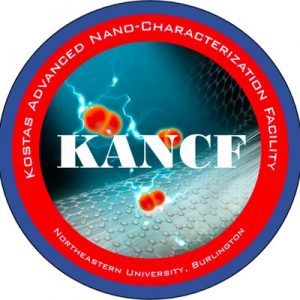Aberration Corrected Transmission Electron Microscope
FEI Titan Themis 300
 Technical highlights:
Technical highlights:
1. Aberration-corrected probe, High brightness Schottky field emitter gun (X-FEG), Flexible high tension range from 60 to 300 kV (60, 80, 120, 200, 300kV) (60 kV and 300 kV are available now)
2. STEM and TEM: up to 70 pm performance in both STEM and TEM at 300 kV
3. Automatic apertures for remote control operation and reproducible recall of aperture positions during aperture change
4. Tilt range ±40 degrees for analytical double tilt holder to orient the maximum amount of zone axis of one crystal in polycrystalline material. With tomography holder even ±75 degrees to minimize the missing wedge in 3D reconstructions
5. Field-free imaging in Lorentz mode with 2nm resolution for magnetic property studies. On special request Cs-corrected field free imaging in Lorentz with ~1nm resolution for magnetic property studies
6. Ultra-fast EDS system: Super-X
• High-sensitivity, windowless EDX detector system based on SSD technology
• Output count rate: up to 200 kcps
• Energy resolution ≤ 136 eV for Mn-Kα and 10 kcps (output), ≤ 140 eV for Mn-Kα and 100 kcps (output)
• 0.7 srad solid angle and 120 mm² combined detector area
• Fast mapping: pixel dwell times down to 10 μs High P/B ratio (Fiori number)>4000
• Excellent in-hole performance (<1% hole counts)
• Low system background in EDX (<1% spurious peaks)
• Detection of all elements down to boron
7. Detectors:
• HAADF detector
• On-axis triple DF4/DF2/BF detectors
• Ceta 16M camera
8. Holders:
• Single tilt holder
• Double tilt holder
• Tomography holder
Focused Ion Beam/Scanning Electron Microscope
FEI Scios DualBeam with Oxford Instruments EDS

FEI Scios™ is an ultra-high-resolution analytical DualBeam™ system that delivers outstanding 2D and 3D performance for a broad range of samples, including magnetic material. With innovative features designed to increase throughput, precision, and ease of use, the FEI Scios is ideal for advanced research and analysis across academic, government, and industrial research environments.
Technical highlights:
1. High resolution field emission-SEM column, with: High stability Schottky field emission gun, Continuous beam current control and optimized aperture angle, Double stage scanning deflection, Dual objective lens combining electromagnetic and electrostatic lenses, 60 degree objective lens geometry, Beam current range: 1 pA to 400 nA, Accelerating voltage range: 200 eV – 30 keV
2. Electron Beam Resolution at Optimum Working Distance
• High vacuum imaging At optimum WD: 0.8 nm at 30 keV, 1.6 nm at 1 keV
3. Stage and Sample
• Maximum horizontal field width: 3.0 mm at 7 mm WD and 7.0 mm at 60 mm WD
• Extra wide field of view (1×) available through standard navigation montage
4. Sidewinder Ion Column
• High-current gallium liquid metal ion source,
• Acceleration voltage: 500 V – 30 kV
• Probe current: 0.6 pA – 65 nA in 15 steps
• Beam blanker standard
• 15-position aperture strip
• Magnification: 40× – 1.28M× based on Polaroid output
• Drift suppression mode as standard for non-conductive samples
5. Ion Beam Resolution
High vacuum imaging, optimum WD 3.0 nm (statistics over 50 edges), 5.0 nm (statistics over 1000’s of edges)
6. Detectors
• Trinity Detection System (in-lens and in-column): T1 segmented lower in-lens detector, T2 upper in-lens detector
• Everhardt-Thornley SED
• IR-CCD
• Nav-Cam™ chamber mountedcamera
7. Sample Holders
• Standard multi-purpose holder, unique mounting directly onto the stage, hosts up to 18 standard stubs (Ø12 mm), three pre-tilted stubs, two vertical and two pre-tilted row-bar holders (38 degrees and 90 degrees).
Rigaku Ultima III X-Ray Diffractometer (XRD)
EBSD system coming soon
Data Analysis
Titan Themis
1. HR TEM/STEM imaging
2. Selected area electron diffraction
3. Energy-dispersive X-Ray spectroscopy
4. 3D reconstruction
Scios Dualbeam
1. HR SEM imaging
2. Energy-dispersive X-ray spectroscopy (EDS)
3. 3D analysis
4. E-beam writing (coming soon)
5. FIB pattern writing
6. FIB TEM/STEM sample preparation
7. Pt ebeam/ion beam deposition

